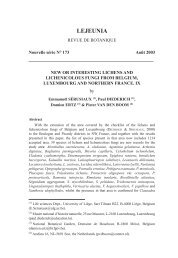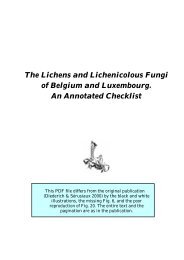A Synopsis of the Genera Skyttea, Llimoniella and - Lichens of ...
A Synopsis of the Genera Skyttea, Llimoniella and - Lichens of ...
A Synopsis of the Genera Skyttea, Llimoniella and - Lichens of ...
Create successful ePaper yourself
Turn your PDF publications into a flip-book with our unique Google optimized e-Paper software.
428 THE LICHENOLOGIST Vol. 32<br />
lichen genus, <strong>and</strong> several well-documented species (e.g. 5 1 . nitschkei <strong>and</strong> S.<br />
gregaria) might even be restricted to a single lichen species. Some species are<br />
known from related, congeneric or even <strong>the</strong> same lichens (e.g. 5. carboneae, S.<br />
lecanorae, S. elachistophora <strong>and</strong> 5. tavaresae on members <strong>of</strong> <strong>the</strong> Lecanoraceae;<br />
S. caesii on Mycoblastus caesius <strong>and</strong> o<strong>the</strong>r sorediate Mycoblastus spp. <strong>and</strong> S.<br />
gregaria on M. fucatus; S. nitschkei <strong>and</strong> S. <strong>the</strong>lotrematis both on Thelotrema<br />
lepadinum), but in none <strong>of</strong> <strong>the</strong>se cases (except perhaps 5. carboneae <strong>and</strong><br />
S. tavaresae) are <strong>the</strong>re indications <strong>of</strong> a closer relationship between <strong>the</strong><br />
corresponding species <strong>of</strong> <strong>Skyttea</strong>.<br />
Curiously, all species (except a specimen <strong>of</strong> S. aff. fusispora on Physcia) grow<br />
on crustose lichens, whilst members <strong>of</strong> <strong>the</strong> Peltigerales, which are known to be<br />
especially rich in lichenicolous fungi (e.g. Hawksworth 19806; Etayo &<br />
Diederich 1996; Hawksworth & Miadlikowska 1997; Wedin & Hafellner<br />
1998), are devoid <strong>of</strong> <strong>the</strong>m. There are more species known on corticolous<br />
lichens than on saxicolous ones, but two (S. elachistophora <strong>and</strong> 5. mayrh<strong>of</strong>eri)<br />
have been collected on both substrata. Most known species seem to be<br />
commensalistic, causing no visible damage to <strong>the</strong>ir hosts. <strong>Skyttea</strong> nitschkei has<br />
been said to be 'most frequent in forests with an exceptionally long history <strong>of</strong><br />
ecological continuity' (Sherwood et al. 1981), <strong>and</strong> Diederich (1991) even used<br />
this species as an indicator for ancient forests with a long historical continuity<br />
in Luxembourg. The widespread 5. gregaria is far from being a ubiquitous<br />
species: in <strong>the</strong> Benelux countries, where <strong>the</strong> host Mycoblastus fucatus is very<br />
common <strong>and</strong> has been carefully screened for lichenicolous fungi in <strong>the</strong> field,<br />
not one single specimen has been found; this species is definitely absent in<br />
large areas <strong>of</strong> <strong>the</strong> distribution range <strong>of</strong> <strong>the</strong> host <strong>and</strong> is possibly restricted to<br />
regions with an oceanic climate. Several o<strong>the</strong>r species have rarely or never<br />
been recorded in Europe although <strong>the</strong>ir hosts are widespread <strong>and</strong> common<br />
(e.g. 5. mayrh<strong>of</strong>eri on Pertusaria or 5. tavaresae on Pyrrhospora quernea); <strong>the</strong>se<br />
species may well be restricted to areas with special ecological conditions. Two<br />
species, S 1 . megalosporae <strong>and</strong> S. <strong>the</strong>lotrematis, which we initially knew only from<br />
<strong>the</strong> Atlantic Pyrenees, have recently been collected by <strong>the</strong> second author in<br />
high altitude forests in Columbia.<br />
Key to <strong>the</strong> species <strong>of</strong> <strong>Skyttea</strong><br />
For <strong>the</strong> identification <strong>of</strong> <strong>Skyttea</strong> species, a good quality dissecting microscope<br />
with a micrometer scale <strong>and</strong> a magnification <strong>of</strong> up to x 40 or x 80 is<br />
necessary for an accurate measurement <strong>of</strong> <strong>the</strong> ascomatal diameter, <strong>the</strong><br />
thickness <strong>of</strong> <strong>the</strong> ascomatal margin <strong>and</strong> <strong>the</strong> diameter <strong>of</strong> <strong>the</strong> pore. Excipular<br />
pigments, which are important diagnostic characters, have to be studied in<br />
water, in K <strong>and</strong> in N. The length <strong>of</strong> excipular hairs is indicated for many<br />
species, but <strong>the</strong> diagnostic value <strong>of</strong> this character should not be overestimated<br />
(except for species with very long hairs). In some species (e.g. S 1 . mayrh<strong>of</strong>eri,<br />
S. nitschkei) 1-septate ascospores have been observed, but this character is<br />
not considered here to be <strong>of</strong> any taxonomic value.<br />
1 Exciple in large parts dark reddish to greyish purplish, sometimes<br />
almost black (red pigment best seen as purplish in C), K+ bright<br />
aeruginose green, <strong>of</strong>ten with additional pigments reacting K+





